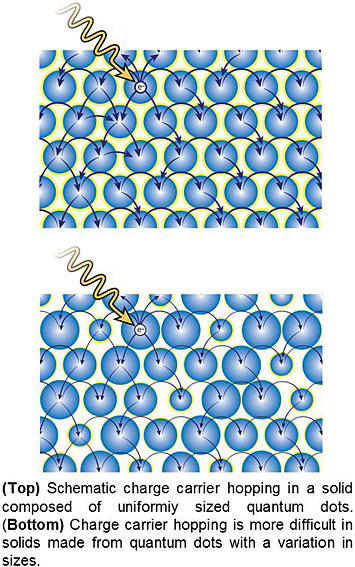Uniform Size Rules the Performance of Quantum Dot Solids
March 30, 2018
What is the scientific achievement?
Researchers from MIT combined ultrafast transient absorption measurements and kinetic Monte Carlo simulations to show that the intrinsic electrical mobility of materials made by assembly of lead sulfide quantum dots decreases with increasing dot size. Furthermore, in realistic solids made from quantum dots with size variations, this structural disorder more strongly degrades the electronic performance relative to other factors.
Why does this achievement matter?
This work quantifies the relative impacts of quantum dot size and size dispersity on important charge transport properties of materials synthesized by assembly of quantum dot components. The results indicate that self-assembly of monodisperse quantum dots into electronically-coupled solids is a pathway to high-efficiency optoelectronic devices.
What are the details?
Energetic disorder in quantum dot solids adversely impacts charge carrier transport in quantum dot solar cells and electronic devices. In this work, scientists from MIT used ultrafast transient absorption spectroscopy to show that the electrical conductivity of PbS quantum dot solids improves monotonically with the PbS size uniformity improves. Furthermore, these measurements show that intrinsic charge carrier hopping rates are faster for smaller quantum dots, which runs counter to the trend commonly observed in quantum dot devices but consistent with theoretical predictions. Fitting the data using a kinetic Monte Carlo model, we extract charge carrier hopping times ranging from 80 ps for the smallest quantum dots to over 1 ns for the largest, with the same ethanethiol ligand treatment. These findings illustrate how small improvements in quantum dot batch size dispersity can dramatically change intrinsic charge carrier hopping behavior, which ultimately affects quantum dot device performance.
CFN Capabilities
Transient absorption measurements were performed in the CFN Advanced Optical Spectroscopy facility.
Publication Reference
Rachel H. Gilmore,† Elizabeth M. Y. Lee,† Mark C. Weidman,† Adam P. Willard,‡ and William A. Tisdale,† Charge Carrier Hopping Dynamics in Homogeneously Broadened PbS Quantum Dot Solids, Nano Letters 17, 893 (2017).
DOI: 10.1021/acs.nanolett.6b04201
Acknowledgement of Support
The authors thank D.-M. Smilgies for performing the GISAXS measurements and M. Y. Sfeir for assistance with transient absorption measurements. We also thank Deniz Bozyigit for helpful discussions. This work was supported by the U.S. Department of Energy, Office of Basic Energy Sciences, under Award Number DE-SC0010538. R.H.G. acknowledges partial support from a National Science Foundation Graduate Research Fellowship under Grant No. 1122374. Transient absorption measurements were performed at the Center for Functional Nanomaterials, Brookhaven National Laboratory, which is supported by the U.S. Department of Energy, Office of Basic Energy Sciences, under Contract No. DE-AC02- 98CH10886. GISAXS measurements were performed at the Cornell High Energy Synchrotron Source (CHESS), which is supported by the National Science Foundation and the National Institutes of Health/National Institute of General Medical Science under NSF award DMR-1332208. SEM was performed in the MRSEC Shared Experimental Facilities at MIT, supported by the National Science Foundation under award no. DMR-08-19762.
2018-12857 | INT/EXT | Newsroom










